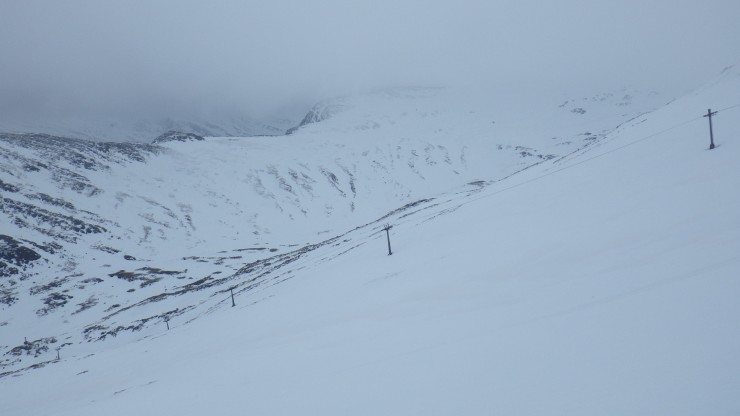Southerly Winds.
15th February 2015
It was another dry day with little change in the snowpack. The Southerly wind was quite strong and affected the operations at Nevis range ski area. I just made it up the gondola before it closed for the day. Southerly and South-Eastlery winds often affect operations the operations of the ski area. The wind from this direction seems to accelerate down the North side of the hill, so in these conditions winds speeds can be the same or greater on the upper part of the gondola line, as on the summit (even although it seems quite calm at the carpark).  Another reason is turbulence of the air, the wind  from this direction is always very gusty. I suspect this might be due to various airstreams coming together in the area around or below the top station (if anyone has an other explanations I would be interested to hear them). Whatever the cause, the effect is very noticeable with the winds jumping from 10mph to 60mph in a few seconds.
After some overnight snow it is looking calmer and colder tomorrow with lighter winds from the West. However, conditions deteriorating later in the week.

Looking over the Braveheart chair towards Stob a Cul Choire. The Southerly winds was pretty strong at this point.Â
Comments on this post
Got something to say? Leave a comment





Dave Cundy
15th February 2015 7:43 pm
As a climber and an ex-paraglider effect, I’d guess that there was either (a) a bit of wave or (b) a bit of Fohn Effect going on, by the sounds of what you describe. With the former, it is set up the by a specific humidity variation with altitude, the windspeed and the upwind hills. As this is never constant, the waves move about a bit, so either the wave comes crashing into the hill where you are (and all hell breaks loose) or it bounces over you (leaving you in a dead spot). I experienced the Fohn once in Grindlewal. Amazing waves of wind crashing down the N face, each one warmer than the last. Every tent in our campsite was felled except the dome tents. You NEVER flew your paraglider if Fohn was forecast.
lochaberadmin
19th February 2015 3:05 pm
Hi Dave, it does sounds like something to do with the effects you describe. Thanks for the information.